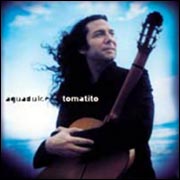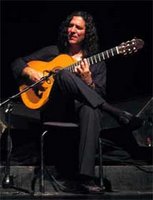





TOMATITO AND HIS GYPSY GUITAR
In Almería, the guitar is synonymous with two names in particular, Antonio de Torres Jurado and Julián Arcas Lacal. In practice, the flamenco guitar itself is centered on two gypsy families, that of Miguel de Almería, also known as Miguel "El Tomate", and the "Josele" family. Niño Miguel and Antonio Fernandez "El Tomate", both professional guitarists, are the sons of Miguel "El Tomate", but the brightest star in the family firmament is Fernandez Torres "Tomatito", born in Almería in 1958, one of the best-known performers of the "toque gitano" today. His style is rhythmic and elegant, and characterized above all by his absolute mastery of the compás. A guitarist without "compás" may play his own music which may have some flamenco characteristics, but it will never be genuine. Over and above his technical ability, his inspiration and imagination, a guitarist is of no interest to the "aficionados" if he loses control of the "compás". Tomatito not only has an innate sense of rhythm but the compás is engraved on his subconscious with the result that he plays it without having to think twice. And, paradoxically, those "toques" where he is most at home - the "bulería", the flamenco "tangos" or the "bulería por soleá" - are precisely the most demanding for "tocaores" and "cantaores" alike. To see him, the "Pope of the bulería" as Juan "Habichuela" once dubbed him, play either in private or at a flamenco meeting, is undoubtedly an unforgettable moment in this music. How can one man have so much flamenco feeling in him, as though he sleeps, breathes and eats the "compás?" It is hardly surprising that his guitar has adapted so well to the people of Cádiz.
What is more, as an artist he directly inherits the gifts of two Gaditans (citizens of Cadiz), themselves worth their weight in gold, and past masters of the rhythms of Andalusia. He was the first to recognize the gifts of Paco de Lucía and Camarón de la Isla, with whom he has share both stage and recording studio since the end of the 1970s. While Paco de Lucía has had a decided influence on his playing, Tomatito has imbued it with a gypsy-style marked by greater use of the right-hand thumb, and the boundless energy which makes his playing so brilliant. For the same reason many other guitarists, whether gypsy or not, have adopted the same style, thus forming a veritable school based on the gypsy "toque" as played by "San Paco de Lucía", as Tomatito calls him, or "St. Paco". It is a striking instance of the mutual exchange between the master musician who drank in flamenco with his mother's milk, and the disciple who, as guardian of the temple, restores the music to its gypsy origins.
As an acclaimed "tocaor" over the years, Tomatito and his guitar have been solicited by most of the best-known contemporary flamenco singers, including Camarón, José Mercé, Pansequito, Enrique Morente and Carmen Linares. And when I write of him as a remarkable "tocaor", this implicitly refers to another vital element that is fundamental to good flamenco playing. As pointed out by D.E.Pohren, a perfect accompaniment is of prime importance to the flamenco guitarist, and is in fact an art in itself. A good accompanist will know all the songs and dances so well that he can follow the slightest whim of the performers, knowing when to stop and when to include "falsetas", adapting to their mood and accompanying them to the climax. And an accompanist capable of all these things will have a decisive influence on the performance of the others. There is no doubt that no "tocaor" has followed these precepts better than Tomatito himself with Camarón. For despite his current predilection for solo guitar work, Tomatito has not bid farewell to his other, "tocaor" half, and continues to work on stage and in the recording studio with the successors of Camarón, such as Remedios Amaya, El Duquenque, El Potito, El Cigala and Montse Cortés.
Right at the start of his career in the 1980s he formed what was to become the most famous of flamenco duos with Camarón, and then, taking the path prepared for him by Paco de Lucía, performed with accompanists such as Antonio and Juan Carmona (Ketama), Antonio Canales and El Duquenque. He is now surrounded with gypsy artists in his groups who thus represent the more ethnic aspect of group flamenco as initiated by Paco. Tomatito can therefore be seen as the bridge between Paco and Camarón's generation and what the media have incorrectly labelled "New flamenco", or "Young Spanish musicians", such as the jazz artists Alameda and Chano Dominguez.
Although Tomatito has clearly established his career as a solo guitarist and flamenco temple guardian, he remains very much a man, a gypsy of his time.
Spain has been witness to a great number of major events over the past few decades. It is hard to remember that this country, a committed member of the European Union, modernizing fast and with an open view on the world, was but a short while ago a country closed in on itself, a spiritual enclave of unprogressive catholicism. After so much introspection and the repression of free thinking as practiced under the Franco regime, today's flamenco players - like all of Spanish society today - are turning their attention to the music that is taking place beyond their frontiers, be it jazz, blues, rock, pop, rap, electronic, reggae, classic, salsa, bossa-nova, Argentine tango or fado. Music in Spain today, encouraged by an active recording industry and lively music societies is a veritable melting post of all cultures. Without turning his back on his gypsy identity - indeed, more determined than ever to make his own voice heard in the multicultural mosaic of contemporary Spain and Andalusia - Tomatito is swinging open the doors of the temple to admit other forms of music, including, for instance, the Argentine guitarist Luis Salinas and the pianist Michel Carmilo, at the same time giving expression to the lives of third and fourth generation gypsy artists, to their way of life and their feelings - people who feel and live life to the full!
TOMATITO, by vicissitudes of fate, spent his formative years alongside the flamenco Prophet of recent times. Whether playing Tarantas or Tangos, he accompanied a genius in whose presence he was to find lifelong inspiration. Destiny thus decreed that he should mature as a musician in the company of the guru from San Fernando whose message still rings out in slums and suburbs, cottages and castles.
Clearly chosen to follow the guiding light of the legend that Camarón de la Isla has become, "Tomate" has since inspired and influenced a whole new generation of young aspiring performers. It is perhaps this element, a kind of divine imprint, which illuminates all of his work and allows him to continue sharing his musical magic using no other device but six strings.
After the demise of Camarón, Tomatito has become a soloist of major significance within the realm of the flamenco guitar. His personal approach to both the festive and traditional formats in flamenco highlight his unique sensitivity and interpretative power. For more than a decade, he has combined loyalty to his racial heritage with an unusual ability to cross ideological barriers. He has renounced imposed cultural restrictions, as well as supposed personal limitations, to enrich his work with harmonic and rhythmic references acquired as a result of embracing Latin Jazz, Rock, Blues, Bossa Nova and other profound resources gleaned from the global musical spectrum.
The collaborators Tomatito surrounds himself with during the creation of Aguadulce are cohabitants of the same cosmic plane on which his own raison d'etre resides. His here and now, his id, is and always will be flamenco. With this in mind, his intention is not only to alleviate the abstinence syndrome he suffers every minute he spends without his guitar in his hands, but also to simultaneously offer all admirers of the genuine in any art-form, a momentary astral journey to the home of authentic duende.


No comments:
Post a Comment